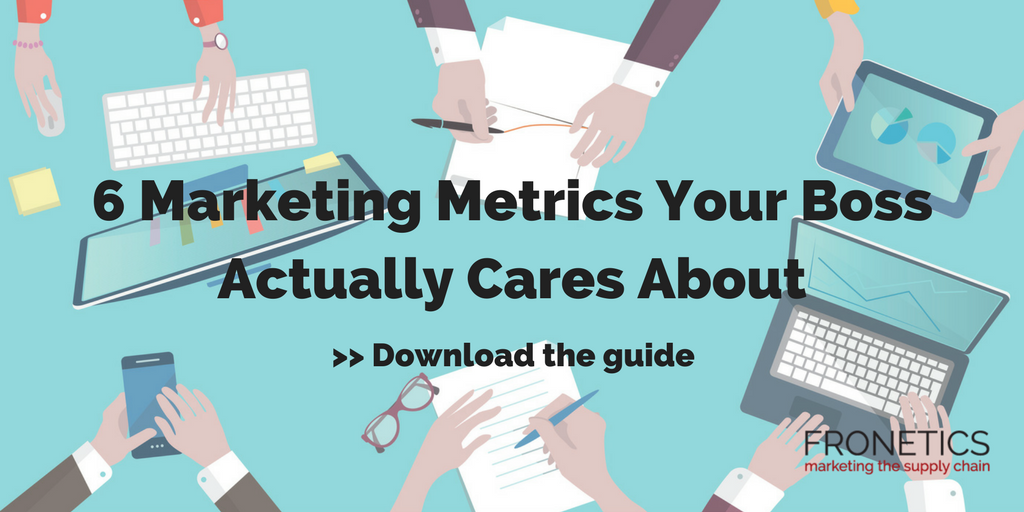
by Fronetics | Aug 22, 2017 | Blog, Content Marketing, Logistics, Marketing, Supply Chain
Supply chain and logistics businesses need to be about more than themselves, and content marketing can help them get there.
While conventional wisdom tells us that content marketing is useful and important for any business, there are still some in the supply chain and logistics industries that remain unconvinced. It’s an understandable conundrum: Content marketing requires significant time, labor, and resources, and it can take quite some time to start reaping benefits.
The bottom line is that studies have shown that of companies with a documented content marketing strategy, 86% find their efforts to be successful in generating new leads, creating lasting relationships with customers, and increased ROI.
How can content marketing make my business better?
Consider this: Content marketing helps a company become more than just another business to customers — it can become a valuable resource for everything related to their products and services.
A good content marketing strategy is about understanding the questions and concerns that are particular to your customer base, and offering quality information and analysis that answers those needs. In the words of River Pools & Spas co-owner Marcus Sheridan, “The moment we stopped saying, ‘We’re pool builders,’ and started saying, ‘We are the best teachers in the world about Fiberglass pools and we just happen to install them as well,’…that was one of the most prosperous days of our lives.”
It’s worth noting that Sheridan was discussing his company’s turnaround from near bankruptcy to becoming a global leader in its field. He attributes this success to switching his company’s mission from selling its product to educating potential buyers — namely, content marketing.
Your business is more than its product.
Recognizing that your business has more to offer than its primary product or service is at the core of what content marketing is all about. Kirk Cheyfitz, CEO of Story Worldwide, puts it this way: “Like a decent human being, brands need to be about more than themselves.”
Start thinking about your business this way. You have a team of people with a tremendous aggregate of experience, expertise, and perspectives. That means that you can offer your audience far more than simply your primary product or service: You can offer them knowledge. Your audience is, in turn, far more likely to become buyers as you provide value — which builds trust and cultivates lasting, fruitful relationships.
What can I do to implement an effective content marketing strategy?
If you’re just jumping on the content marketing bandwagon, it’s an exciting time for your business. You might want to check out our Twelve-Step Guide to a Content Marketing Strategy and other resources to help you through the process.
A visual content audit is a solid first step. The main thing to keep in mind is that you have valuable resources at your disposal that you can offer your audience of potential buyers — start sharing!
Related posts:


by Fronetics | Jul 6, 2017 | Blog, Content Marketing, Data/Analytics, Marketing
Businesses report these 3 content marketing challenges are the largest they face. Here’s how to track your progress in overcoming them.
Is content marketing working well for your business? If not, you are not alone. Though it is one of the most effective ways to grow your business, content marketing has been challenging B2B and B2C organizations since its inception.
You may think it should be simple: Write, post, get more customers. But content marketing is much more complex, demanding more time, thought, and careful strategy than churning out a few blog posts.
First and foremost, what you produce must engage readers. This is, however, one of the biggest content marketing challenges facing both B2B and B2C marketers.
In fact, the 2017 State of Inbound Report found that content creation is just the tip of the iceberg in terms of content marketing challenges that businesses face. Here are 3 marketing challenges and ways to track your progress in overcoming them.
3 content marketing challenges
1. Generating traffic and leads
Echoing their priorities, marketers today find generating traffic and leads to be their biggest challenge. In fact, 61% of those surveyed listed it as their number one challenge. ‘Content is king’ has become a marketing mantra, but how can you turn your content into actual leads that turn into sales?
Tying revenue directly to publishing and distributing content can be difficult. Thinking about social media content within the context of your entire sales funnel can make it easier to determine effectiveness. Content is typically used to attract leads, to encourage readers to subscribe to your blog, or to have prospects submit contact info to get higher-value content. Continued engagement nurtures leads and moves them further down the sales funnel.
Track this: The cost to get a lead. You can then determine the percentage of leads that move on to become qualified leads, the percentage of qualified leads that then become opportunities, and the percentage of opportunities that are ultimately won. At the end of the day, you’ll be able to calculate the revenue generated from leads that entered the funnel from your content marketing efforts.
2. Proving the ROI of marketing activities
Coming in at a close second, 43% of marketers felt that proving their ROI from content marketing activities was their biggest challenge.
Whether launching a product or a new social media campaign, we look for instantaneous numbers that will affirm we made the right choices. But here’s the problem: Not all metrics are created equal. Content marketing ROI is harder to confirm than checking a few quick numbers.
Lean-startup pioneer Eric Reis said, “The only metrics that entrepreneurs should invest energy in collecting are those that help them make decisions.” In other words, measuring your ROI will tell you if an effort was profitable so you know where to put your time and money.
ROI can help you determine whether it was worth spending your resources in a particular way. This is extremely useful on platforms like blogs and social media, where things are constantly changing. Using ROI as a litmus test, you can keep experimenting and making sure you’re using these tools effectively.
Track this: Use tools like HubSpot, Hootsuite, and built-in analytics platforms like Twitter Analytics, Facebook Insight, and YouTube Analytics to track detailed information about engagement with your content.
3. Budget
Organizations that have a documented content marketing strategy are more likely to be successful than those that don’t. But setting aside the funds to develop and implement these strategies can be tricky.
The State of Inbound Report found that 30% of marketers struggle to secure a budget for their marketing efforts. Content marketing competes with other marketing campaigns (outbound, native, etc.) for funding. The Content Marketing Institute’s latest trends report states that, on average, 29% of B2B brands’ total marketing budget is spent on content marketing, leaving a majority of funding going toward other efforts.
Content marketing is here to stay. In fact, it’s at its best when it’s integrated with your other marketing efforts, becoming a part of your entire marketing strategy.
Track this: Content marketing serves every marketing channel. Experiment with overlapping marketing budgets to increase your efforts for whitepapers, sales collateral, social media posts, and to make sure your advertisements and visual messaging are in sync. Content serves every marketing channel, so you’re wasting time claiming you don’t have the budget.
Related posts:


by Fronetics | Jun 6, 2017 | Blog, Content Marketing, Marketing
If you’re committing these content marketing don’ts, you could be turning off clients and prospects instead of attracting them.
As a marketer, your job is to attract customers and prospects — so the last thing you want to do is misfire and scare people away. Yet, only a third of content marketers rate their content marketing strategy as extremely or very effective. You want — and need — to be a voice that steers a company through our ever-changing times. But even with the best intentions, you might be approaching your customers with the wrong tone, and that can cost you.
We’ve got just the plan to make sure your content is in check with what customers want. Here is our list of content marketing don’ts — our top four offenders that scare away customers.
4 content marketing don’ts
1) Don’t be generic.
Understand your audience and what makes them click. Clients want to feel special and understood in a subtle way. If a message isn’t personable and personalized, you run the risk of running customers off and disengaging them.
Create content that is audience-focused, honing in on what your audience wants to read, not what you want to tell them. Do your research and position your content marketing strategy to focus on customer and prospect needs, not yours.
2) Don’t try to sell, sell, sell.
Trying to pass your sales pitch off as content will only hurt your content marketing efforts. Readers view content that isn’t sincere, informative, or authentic as disingenuous, and they’ll quickly turn away.
The same goes for content that’s filled with excessive keywords and multiple links meant to boost SEO results. Everything should be done in moderation so the customer — and search engines — aren’t turned off.
Don’t expect your content marketing strategy to result immediately in increased dollars. Building rapport takes time with an often-delayed payout.
3) Don’t sacrifice quality.
If your content is shoddy and low quality, your clients and prospects won’t bother with it. By and large, your customers value quality, consuming content that offers value and is relevant to their lines of business.
Rather than multiple low-quality postings, stellar content that stands out and teaches readers something will go a long way. And adding a variety of media (e.g., photos, videos, slides) to posts contributes to their value and boosts credibility. Including a well-done graphic or pulling out an especially relevant quote from an expert makes each piece of content pop.
4) Don’t go unplanned.
Ensure your content is relevant by documenting a strategy, following it, and adjusting it as needed. An editorial calendar is a great place to start. (See below for a free editorial calendar template!)
Brainstorm ideas for content with colleagues and clients. Document your goals and methods and create a plan for attaining them, giving your marketing plan organizational clarity. Consistency is king — haphazard content marketing won’t get you anywhere.
Related posts:


by Fronetics | May 31, 2017 | Blog, Content Marketing, Data/Analytics, Marketing, Social Media
Analyzing the right metrics is crucial to determining whether you are achieving content marketing ROI.
We all want to see the fruits of our labors. Whether launching a product or a new social media campaign, we look for instantaneous numbers that will affirm we made the right choices. But here’s the problem: Not all metrics are created equal. Content marketing ROI is harder to confirm than checking a few quick numbers.
A spike in homepage hits may be the result of your marketing efforts, or it may be because of ghost spam. (Or, both.) Regardless, more visits do not necessarily correlate to increased revenue — just more visits. Even so, 83% of B2B enterprise companies (over 1,000 employees) use web traffic as their main metric for measuring content marketing ROI.
The number of email subscribers is another common success metric. But, again, having 100,000 email subscribers means nothing if only 0.001% are opening them. You actually could be losing money in terms of resources allocated if the emails aren’t helping drive sales. That’s why it is crucial to focus on your company’s return on investment (ROI). You could waste hours reviewing a hundred different analytics that tell you nothing about how revenue was affected by a particular effort.
Know where to allocate resources
Lean-startup pioneer Eric Reis said, “The only metrics that entrepreneurs should invest energy in collecting are those that help them make decisions.” In other words, measure the things that will tell you if an effort was profitable so you know where to put your time and money.
ROI can help you determine whether it was worth spending your resources in a particular way. This is extremely useful on platforms like blogs and social media, where things are constantly changing. Using ROI as a litmus test, you can keep experimenting and making sure you’re using these tools effectively.
According to our Social Media Use Report, 81% of respondents wanted a tracking and measuring tool to prove their ROI. Your resources are limited, so it’s crucial to evaluate your efforts with meaningful numbers that illustrate their affect on your bottom line.
So what are they best metrics to use? Here are three of our favorite tools.
3 tools for measuring content marketing ROI
1) Built-in Social Media Analytics Tools
Most social media platforms have their very own built-in tools that give you detailed information about engagement with your content. Even better, most of these tools are free. Twitter Analytics, Facebook Insight, and YouTube Analytics are just a few examples of tools you can use to measure exposure and engagement with your followers. This priceless information will help you gain a better understanding of your followers and the content they are drawn to.
2) Hootsuite
Hootsuite promotes smarter, data-driven social media marketing decisions backed by real-time analytics that allow you to spot trends as they develop and drill down for insights on how your social content is performing. It takes all your top social media platforms (Twitter, Facebook, YouTube, LinkedIn) and combines them into one application for full-scope results.
3) HubSpot
Measuring ROI through HubSpot is both accurate and convenient. HubSpot sends you weekly updates on your campaign performance and allows you to pull any reports of your own. Standard analysis includes: visits, leads, percentage changes, submissions, bounce rate, downloads, and much, much more. HubSpot Marketing Analytics can identify blog articles, landing pages, emails, and social media posts that perform well in terms of specific keywords.
Calculating ROI might take some time — both in the few extra minutes to do the math and the amount of time that needs to pass before all the data is available — but that number will be invaluable to you.
Let us help you get started. We’ve created a monthly marketing reporting template just for you. This template tracks your marketing metrics and generates graphs you can use in reporting and presentations. Click the button below to get the template (an Excel document) now.

Related posts:


by Fronetics | May 24, 2017 | Blog, Content Marketing, Marketing
Ready to give up on content marketing? Chances are, you haven’t given it a fair shot.
You’re three or maybe even six months into your new content marketing program. Congratulations! You’re probably noticing an uptick in web traffic, social reach, and other engagement metrics like time on page. You’re right on track! But you have no leads or sales to speak of. And whether that’s got you nervous that you’re doing something wrong, or just has your boss breathing down your neck to get some results FAST, I’m here to tell you: Now is NOT the time to give up on content marketing.
In fact, giving up now is just about the worst thing you can do. You’ve already made the majority of the investment without giving your program time to deliver your return.
Why does content marketing take so dang long to work?
Content marketing is a long-term solution that helps businesses build brand awareness, grow their audience, and generate new leads and sales. But it takes time and effort to achieve results. You shouldn’t give up on content marketing before the seeds you sow have time to bear fruit.
Just how long will it take for your content marketing strategy to yield results? Well, that really depends on your business and your goals, but you can count on at least six months. (Joe Pulizzi, founder of the Content Marketing Institute, says more like 18.) The point is, content marketing is not a magic, overnight solution. The reason reflects why content marketing is effective in the first place.
4 reasons why it’s NOT time to give up on content marketing
1) Developing your strategy takes time.
Only 11% of companies without a documented content marketing strategy find their efforts to be successful, compared to 60% of companies with a strategy in place. (That number rises to 86% when the company designates someone to lead the strategy.) The significant increase in effectiveness can be attributed to the careful thought and research that goes into building a strategy.
You will need several months to build the foundation of your content marketing plan if it is to be effective. You need time to research the kind of content that resonates most with your audience and to truly understand the (very specific) demographic that finds value in what your company offers. Then you need time to determine and test which distribution channels will most effectively reach your target audience, to discern a plan for content production, and to build out an editorial calendar reflective of your strategy.
Without getting all of these pieces precisely right, you’ll waste an enormous amount of energy and resources working on an ineffective strategy. Take the time to evaluate the market for your business and its content marketing strategy, and you’ll realize results in time.
2) Becoming an authority takes time.
The goal of your content marketing efforts should be to be a consistent source of information and value to your audience, who gradually will come to trust your authority and reward you with their business when they are ready to make a purchase. And establishing yourself as an expert doesn’t happen overnight.
Consistency is key for two reasons. For one, the average B2B buyer consumes between two to five pieces of content before making a purchase decision. If your content is old, arbitrary, contradictory, or otherwise unreliable, buyers will chose a different vendor whose content is more trustworthy. Consistent and consistently good content keeps your target audience engaged and builds your credibility with them.
Secondly, search engines rank websites based on several factors, and one of the most important is consistency. If your company blogs every other month, compared to companies that post several days a week, your posts will be penalized in search results. And since very few readers click beyond the top five search results, you’re drastically reducing your organic search potential.
As a SumAll article put it, “Whether getting traffic to your blog or your content ranked in the search engines, it doesn’t happen overnight, but instead by repeatedly creating and distributing quality content on a frequent basis for the long-term.”
3) Building your audience takes time.
The B2B buying process is becoming longer and more complex because the majority of buyers (82%) are using more sources to research and evaluate products and services, and they are spending more time in the research phase itself. In fact, 71% of B2B researchers start with a generic search — rather than searching for a particular company — and do an average of 12 searches before even engaging with a specific brand’s site. They are 57% of the way down the sales path by this point, meaning they have already spent a fair amount of time educating themselves with the enormous amount of information available to them on the internet.
This means you need to allow your target audience time to find you and complete thorough research about you and your competitors before you even realize that the lead exists. And likely there will be more time before a sale takes place.
Content marketing is much more about lead nurturing than producing instant results. As you build your reputation as a valuable source of information, you will simultaneously build a loyal following of readers and content consumers who continue to return to you for knowledge and, ultimately, purchases. Relationship-building is not a streamlined process, but it does foster the ever-valuable repeat business that will have a greater impact on your bottom line than a one-and-done sale.
4) Your sales cycle takes time.
Unfortunately, content marketing cannot decrease the length of your sales cycle. Thus, you can’t expect to see the fruits of your labors (in terms of dollars) until at least one cycle is complete.
There should be, however, hints along the way that your efforts are working. Metrics like increased website traffic, email registrations, and social reach offer clues that more potential customers are finding your business in their research. You should take these signs and continually evolve your strategy to accommodate what is working for your business.
Also keep in mind that while content marketing can have an enormous impact on generating and nurturing leads, it does not deliver sales on a silver platter. Sales teams still play a major role in building on those relationships and closing deals.
Please don’t give up on content marketing before it’s had time to play out. You’ll not only lose out on your initial investment, but also all the leads and sales that will eventually come your way once your program has had time to develop fully.
Related posts:











